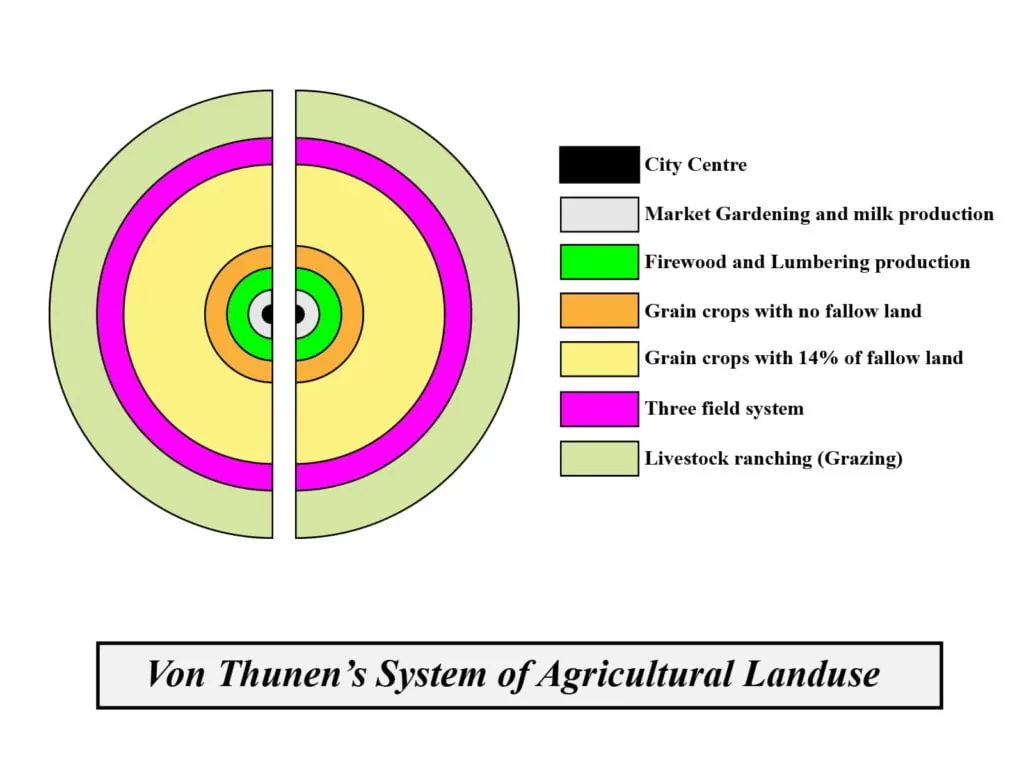After covering the Weber’s theory of industrial location, I have covered a very important topic of Human Geography, Von Thunen theory of agricultural location. For the exam perspective, this topic is very important for geography optional in bpsc and upsc.
Table of Contents
Introduction
The agricultural location theory is a normative economic model which was first presented in 1826 in a book called Der Isolierate Stat. This theory is based on the concept of Economic Rent which is prevalent in farm market distance relationship. The agricultural location theory is one of the earliest attempts to explain the pattern of land use in economic terms which was proposed by Von Thunen.
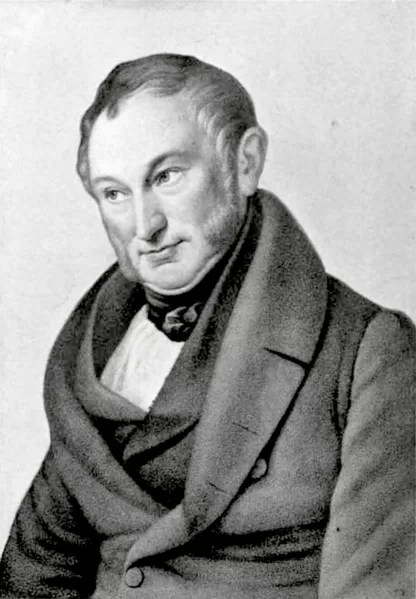
Von Thunen theory of agricultural location predominantly concerned with the agriculture, types of agriculture and prosperity of an urban market. He devised this theory by calculating the relevant data of last five years of Mecklenburg. Above all, the main aim of Von Thunen’s model on agricultural location was to show how and why agricultural land use varies with the distance from the market.
Based onthe value of productionof variedagricultural produce, yields, cost of transportation and market prices, he demarcated six concentric zones with different agricultural production.
Postulates of Von Thunen Model
- At the centre of the agricultural region, there is an isolated state having no connection with the world outside.
- The agricultural region has a city in its core and agricultural hinterland around that city.
- Physiographically, the agricultural location was homogeneous (in terms of relief, soil and climate).
- The cost of transportation and distance covered are directly proportional to each other.
- The surplus crop must be sold only in the market.
- There was only one mode of land transportation (horse and cart).
- The farmers of the agricultural hinterland were supposed to be optimizer (a rational and an economic man).
- Von Thunen also presumed that each farmer has complete information about agriculture. Due to their agricultural knowledge, they make rational decisions to increase their profit.
Economic rent
Economic rent is defined as the net income accruing to an area of land above the net income of land at the economic margin of production. The economic rent of a crop increases if the location of agricultural land is near the market due to less transportation cost. Von Thunen’s concept of economic rent is also known as locational rent since the economic rent is estimated by the location of agricultural land.
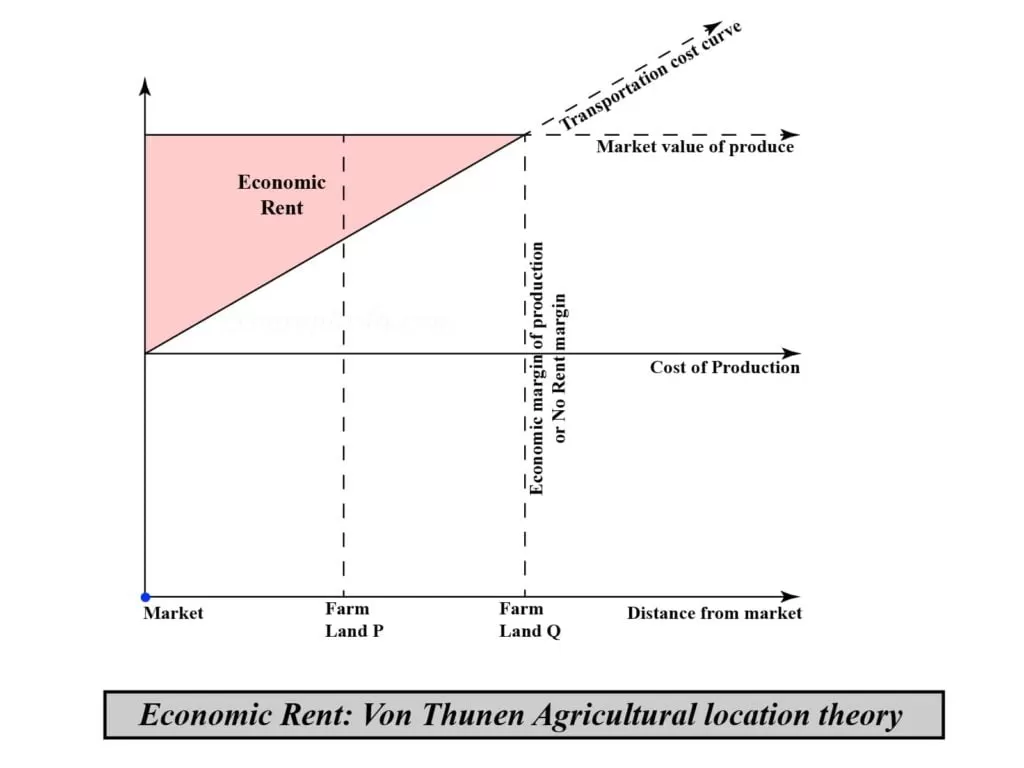
Models of Von Thunen theory of agricultural location
Intensity Theory
Due to the rise in transportation cost, intensive cultivation is most suitable near the city centre. Therefore, the intensity of production of a particular crop declines with distance from the market.
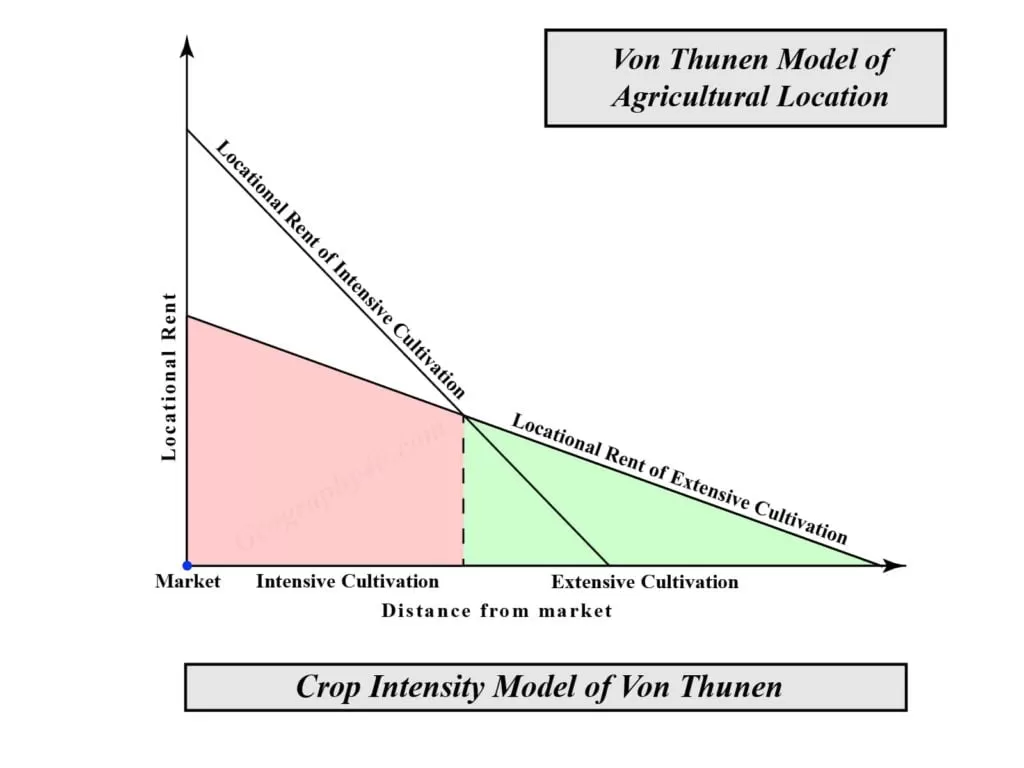
Crop theory
According to crop theory, there will be a variation in the land use with distance and the factors responsible for the variation in the land use pattern are market price of a particular crop, transportation cost, production cost and yield per unit of land. The crop theory of Von Thunen can be understood by taking the following two cases.
Case- 1
When two crops P and Q have the same production cost and yield but having different transport cost and market price. If P is costlier to transport and has a higher market price then crop P will be grown closer to the market than Q. Due to higher transportation cost of crop P, the location rent of P decreases more rapidly.
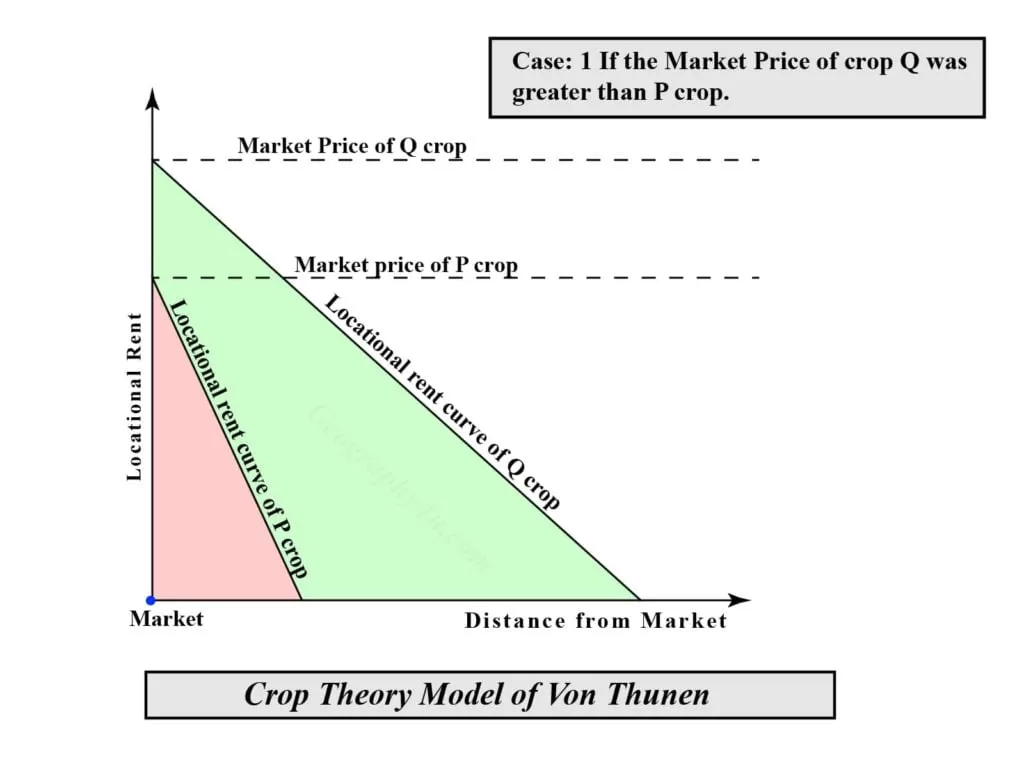
Case- 2
When two crops X and Y have the same production and transportation cost (per tonne/km) but different market price and yield per unit of land. If X has a higher yield and lower market price than Y, it will be grown closer to the market than Y.
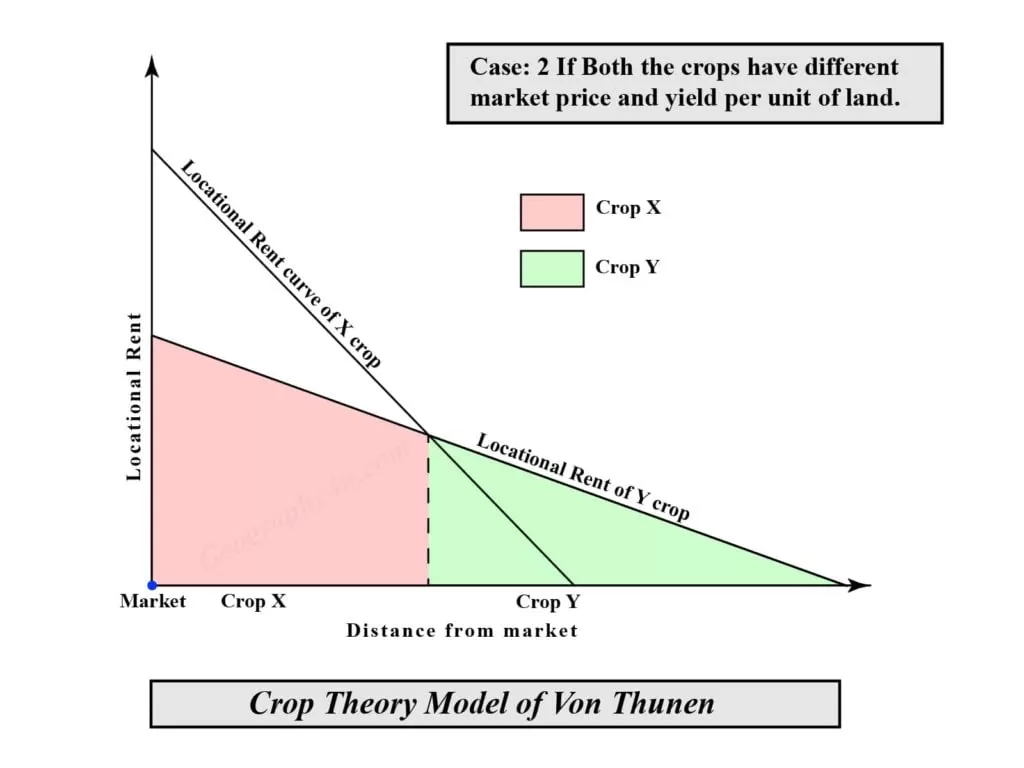
Concentric zonal rings of agricultural production
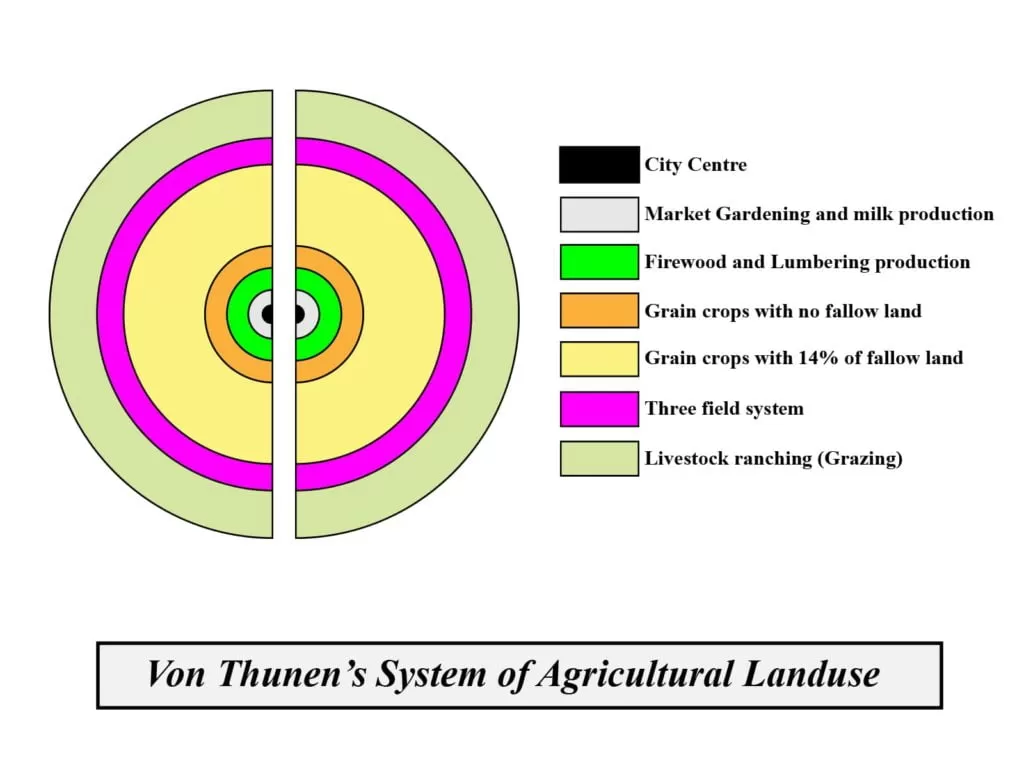
Zone-1: Market Gardening and milk production
The zone-1 would be dedicated to cash cropping. Due to deficiency of food preservation facilities, primitive modes of transportation and highly perish nature of products, market gardening and milk production were most suitable in this zone.
Zone-2: Firewood and Lumbering production
The second zone was marked by the production of firewood. Due to heavy bulkiness and primitive transportation modes, wood was comparatively costly to be shipped. It was also used as a fuel and building material. However, the outer limit of this zone was marked by wood which was highly in demand in the market.
Zone-3: Grain crops with no fallow land
Unlike zone-2, the zone-3 was marked by food grains. Rye was the most important market product of this zone, having no fallow land. The cropping intensity of this zone was highest as compared to zone-4 and zone-5. Most importantly, grains could be stored, easy to transport and last longer than milk products. Also, the agricultural land would be cheaper farther away from the market.
Zone-4: Grain crops with 14% of fallow land
This zone was marked by 14% of fallow land, having less crop intensity as compared to zone-3. The farmers of this zone usually practised seven years crop rotation with one year each rotation of rye, barley and oats, three-year rotation of pastures and one year as fallow land.
Zone-5: Three field system
Like zone-2, this zone was marked by extensive cultivation having 33% of land as fallow. The farmers of this zone practised three-field system, having 1/3rd of land as crop field, 1/3rd as pastures and rest left for fallow land.
Zone-6: Livestock ranching (Grazing)
The market products of this zone would be of two types namely, livestock and by-products of milk like cheese, butter, etc. which would not highly perishable. Also, the reduction in the volume of these by-products made them cost-effective in terms of transportation.
Modifications in Von Thunen model of agricultural location

Despite the classical model of Von Thunen, he also incorporated other factors which directly impact the demarcation of agricultural location. The following are the modification introduced in the classical model of Von Thunen.
- Introduction of a navigable river into his Isolated State.
- Elongation of production zones along the river.
- Extension of Zone-2 in a narrow band.
- Consideration of more than one market centre or minor market centres.
- Possibility of numerous small towns of equal importance.
- Intermixing of production zones due to numerous towns.
- How did the theory of plate tectonics evolve over time?
- 7 Criticisms of Continental Drift Theory by Alfred Wegener
- Malthus theory of population: critical analysis & relevance
- Major Types of Clouds formation and their Characteristics
- Get Detailed Bpsc syllabus 2022-23
- Complete bpsc geography optional syllabus 2022
- Major mineral resources of India with maps
- Von thunen theory of agricultural location
- Weber’s theory of industrial location

